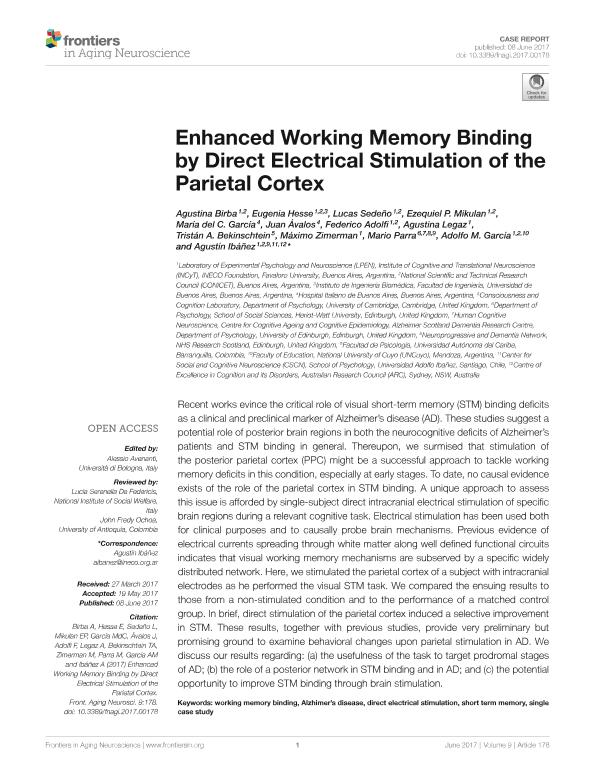Artículo
Enhanced working memory binding by direct electrical stimulation of the parietal cortex
Birba, Agustina ; Hesse Rizzi, Eugenia Fátima
; Hesse Rizzi, Eugenia Fátima ; Sedeño, Lucas
; Sedeño, Lucas ; Mikulan, Ezequiel Pablo
; Mikulan, Ezequiel Pablo ; García, María del Carmen; Avalos, Juan Carlos; Gonzalez Adolfi, Federico
; García, María del Carmen; Avalos, Juan Carlos; Gonzalez Adolfi, Federico ; Legaz, Agustina
; Legaz, Agustina ; Bekinschtein, Tristán Andrés
; Bekinschtein, Tristán Andrés ; Zimerman, Máximo; Parra, Mario; García, Adolfo Martín
; Zimerman, Máximo; Parra, Mario; García, Adolfo Martín ; Ibañez, Agustin Mariano
; Ibañez, Agustin Mariano
 ; Hesse Rizzi, Eugenia Fátima
; Hesse Rizzi, Eugenia Fátima ; Sedeño, Lucas
; Sedeño, Lucas ; Mikulan, Ezequiel Pablo
; Mikulan, Ezequiel Pablo ; García, María del Carmen; Avalos, Juan Carlos; Gonzalez Adolfi, Federico
; García, María del Carmen; Avalos, Juan Carlos; Gonzalez Adolfi, Federico ; Legaz, Agustina
; Legaz, Agustina ; Bekinschtein, Tristán Andrés
; Bekinschtein, Tristán Andrés ; Zimerman, Máximo; Parra, Mario; García, Adolfo Martín
; Zimerman, Máximo; Parra, Mario; García, Adolfo Martín ; Ibañez, Agustin Mariano
; Ibañez, Agustin Mariano
Fecha de publicación:
06/2017
Editorial:
Frontiers Media S.A.
Revista:
Frontiers in Aging Neuroscience
ISSN:
1663-4365
Idioma:
Inglés
Tipo de recurso:
Artículo publicado
Clasificación temática:
Resumen
Recent works evince the critical role of visual short-term memory (STM) binding deficits as a clinical and preclinical marker of Alzheimer's disease (AD). These studies suggest a potential role of posterior brain regions in both the neurocognitive deficits of Alzheimer's patients and STM binding in general. Thereupon, we surmised that stimulation of the posterior parietal cortex (PPC) might be a successful approach to tackle working memory deficits in this condition, especially at early stages. To date, no causal evidence exists of the role of the parietal cortex in STM binding. A unique approach to assess this issue is afforded by single-subject direct intracranial electrical stimulation of specific brain regions during a relevant cognitive task. Electrical stimulation has been used both for clinical purposes and to causally probe brain mechanisms. Previous evidence of electrical currents spreading through white matter along well defined functional circuits indicates that visual working memory mechanisms are subserved by a specific widely distributed network. Here, we stimulated the parietal cortex of a subject with intracranial electrodes as he performed the visual STM task. We compared the ensuing results to those from a non-stimulated condition and to the performance of a matched control group. In brief, direct stimulation of the parietal cortex induced a selective improvement in STM. These results, together with previous studies, provide very preliminary but promising ground to examine behavioral changes upon parietal stimulation in AD. We discuss our results regarding: (a) the usefulness of the task to target prodromal stages of AD; (b) the role of a posterior network in STM binding and in AD; and (c) the potential opportunity to improve STM binding through brain stimulation.
Archivos asociados
Licencia
Identificadores
Colecciones
Articulos(OCA HOUSSAY)
Articulos de OFICINA DE COORDINACION ADMINISTRATIVA HOUSSAY
Articulos de OFICINA DE COORDINACION ADMINISTRATIVA HOUSSAY
Citación
Birba, Agustina; Hesse Rizzi, Eugenia Fátima; Sedeño, Lucas; Mikulan, Ezequiel Pablo; García, María del Carmen; et al.; Enhanced working memory binding by direct electrical stimulation of the parietal cortex; Frontiers Media S.A.; Frontiers in Aging Neuroscience; 9; 6-2017; 1-7
Compartir
Altmétricas



